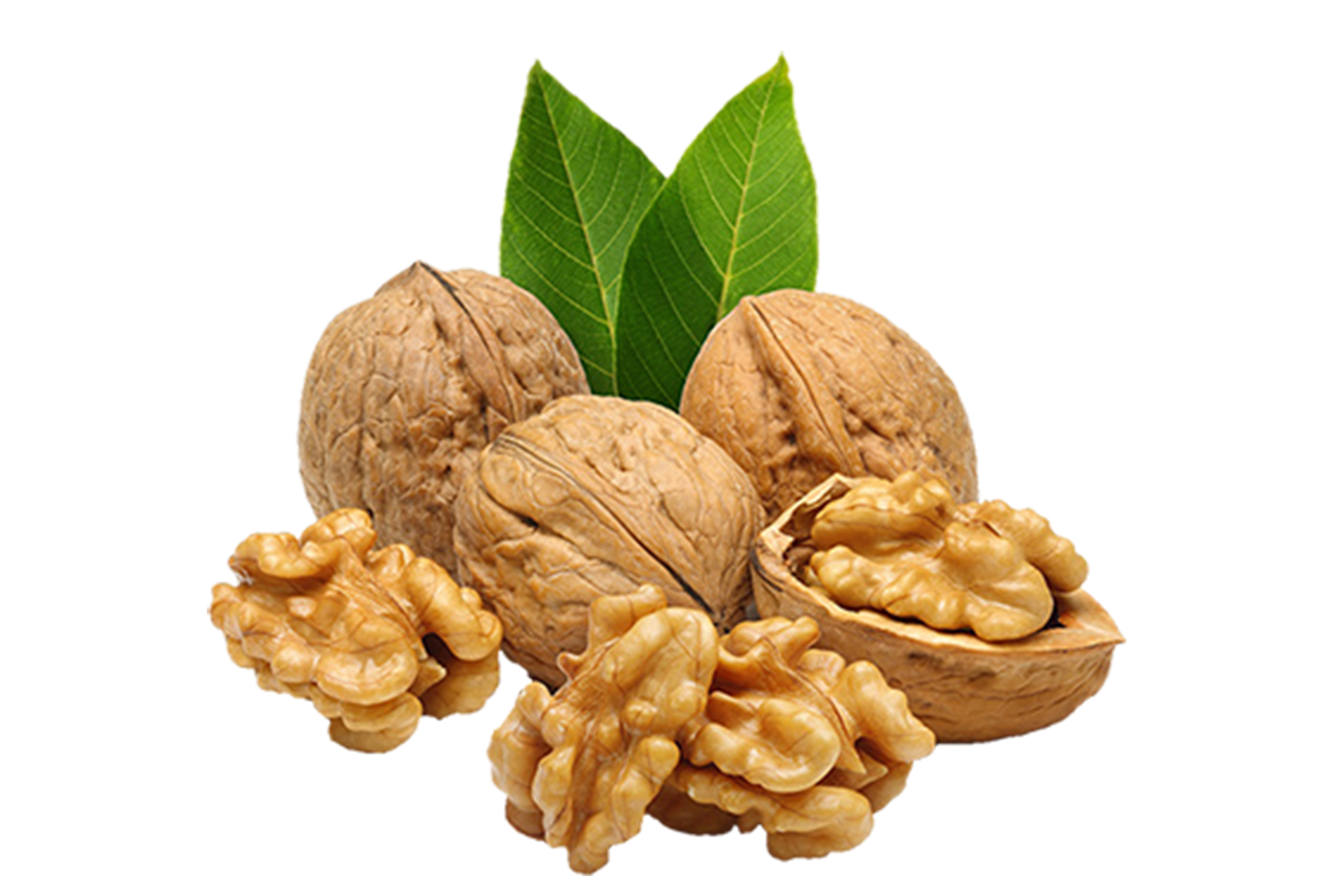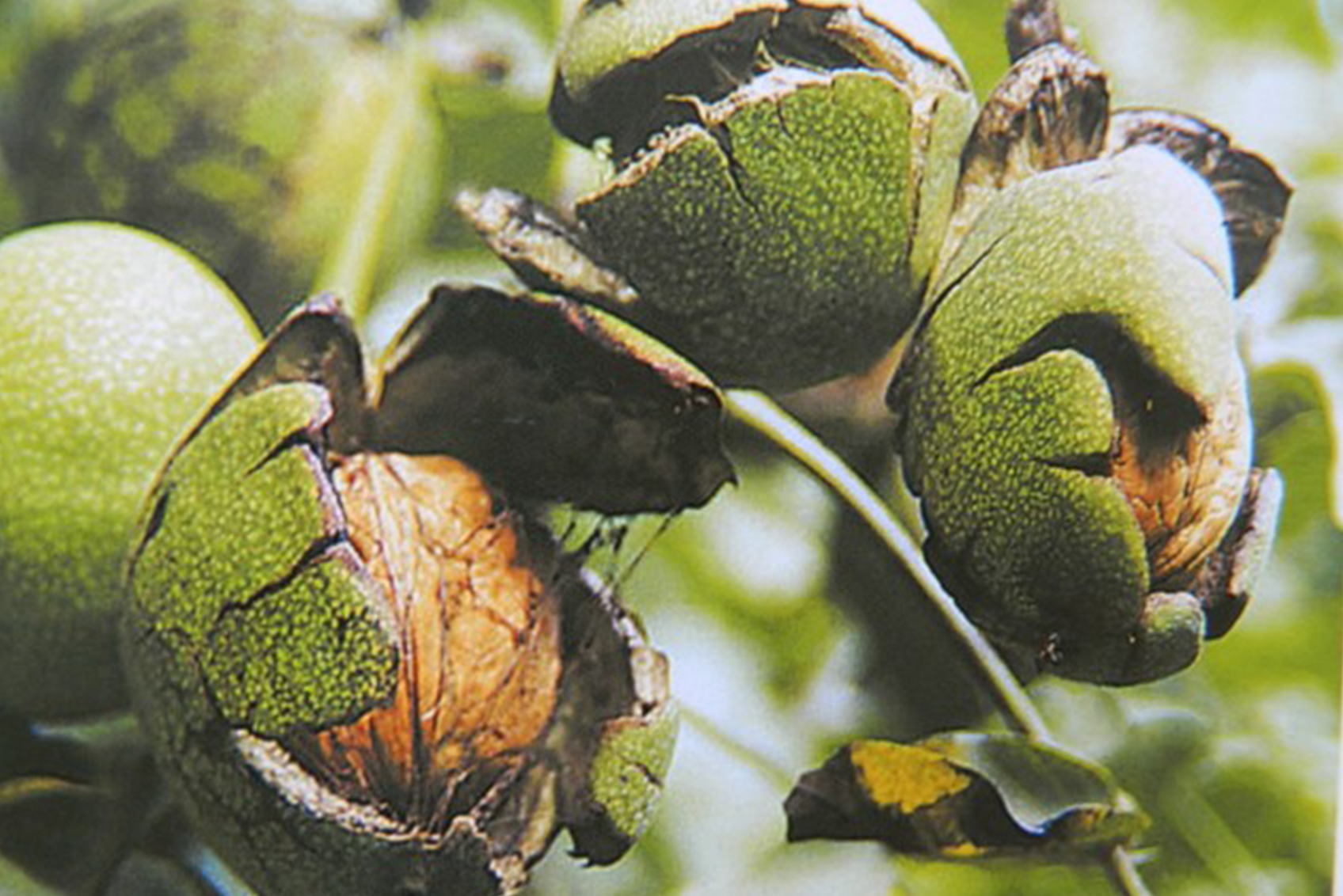Walnut
Walnuts are revered since ancient times as a symbol of intellectuality, since their kernels have convoluted surface inside the shell resembling as that of brain.
They have got much attention in these days as they are enriched with many health-benefiting nutrients, especially Ω-3 fatty acids that are essential for optimum health.
Nearly 2.15 lakh people are directly or indirectly involve with walnut industry in the India.

| Walnut (English or Persian Walnut) | |
|---|---|
| Genus | Juglans |
| Species | regia |
| Family | Juglandaceae |
| 2n | 32 |
| Origin | North Western Himalayas |
| Plant type | Monoecious |
| Fruit | Nut |
| Constituent | Quantity/100g |
|---|---|
| Water | 3.5 |
| Protein | 14.8 |
| Carbohydrate | 15.8 |
| Fat | 64.8 |
| Fibre | 2.1 |
| Ash | 1.9 |
| Calcium | 99 mg |
| Iron | 3.1 mg |
| Magnesium | 131 mg |
| Phosphorous | 380 mg |
| Potassium | 450 mg |
Walnuts Varieties Of India
Jammu & Kashmir : Lake English, Drainovsky and Opex Caulchry ,CITH 1 to CITH 10, Bhusan (Gl0109)
Himachal Pradesh : Gobind, Eureka, Placentia, Wilson, Franquetfe And Kashmir Budded
Uttarakhand : Chakrata Selection, JSR 1504 (Selection)
| S. No | Name of the variety | Net weight (g) | S. No. | Name of the variety | Net weight (g) |
|---|---|---|---|---|---|
| 1. | Chandler | 13.2 | 9. | Sexton | 15.6 |
| 2. | Fernette | 14.9 | 10. | Solano | 14.6 |
| 3 | Forde | 15.5 | 11. | Sunland | 17.9 |
| 4 | Gillet | 15.2 | 12. | Tehama | 14.1 |
| 5 | Howard | 14.3 | 13. | Tulare | 14.1 |
| 6 | Ivanhoe | 12.8 | 14. | Vina | 12.6 |
| 7 | Payne | 12.9 | 15. | Serr | 14.4 |
| 8 | Robert Livermore | 12.9 | 16. |



Characteristics of Lateral Bearing walnut varieties
Tulare
- Bears mostly on Laterals
- Mid season variety
- Precocious and heavy bearer
- Nuts are large, round and well sealed
Chandler
- Bears exclusively on laterals
- Precocious with very high yields
- Resistant to blight
- Nuts are smooth, round, good shell seal
- Light kernels shell out easily
Lara
- Precocious and bears heavily even on young trees
- It is an exclusively lateral bearer variety
- Nuts well sealed and have light kernels that are large and easy to remove
- It is resistant to blight
Serr
- Fruits exclusively on laterals
- Precocious and high yielder
- Resistant to blight
- Nuts are large, well sealed and have light kernels
Maturity
Walnut matures 2-3 weeks prior to hull dehiscence
Should be harvested prior to shuck split when the seed coat is a light tan colour (market preference)


Harvesting
In India most of the Harvesting is organised manualy by climbing on the tree or by sticks
Dehulling of walnuts
Walnuts can be successfully and conveniently dehulled by giving a post harvest dip in a 500 ppm solution of ethephon. The fruits are heaped and kept undisturbed for 4-5 days. The hull starts loosening and readily separates out exposing the nut. The fruits treated by ethephon do not turn black.

Storage Of Walnut
The optimum temperature range of storage is 0 to 10° C and 50-65% relative humidity to maintain 4% moisture.
Walnut are stored in gunny bags in a ventilated room free from excess humidity.
The quality of nut meat deteriorates due to darkening and rancidity which are affected by air, moisture, heat and light.
Gallery








Nut Categories
Paper shelled nuts- Very thin, splits at one end, not desirable
Thin shelled nut- Easy to crack, shelling percentage 45-50
Medium shelled- Shell neither too thin nor too thick, kernel recovery 32-35% preferred in International market
Medium shelled- Shell neither too thin nor too thick, kernel recovery 32-35% preferred in International market
Hard shelled nut- Usually small in size and difficult to crack, poor kernel recovery (<20%)
Nut And Kernel Quality
The nuts should be medium to large (12-18g) in size
The nuts should be light coloured and medium shelled
Nuts should be smooth and well sealed
High shelling percentage (50%)
Should separate easily from the shell
Kernel should have white or light coloured skin
Should have good taste and flavour
Average Nut Size should be 30mm
Possibilities of Development
Vegetatively propagated planting material
Reducing-Long juvenile period
Reducing-Large tree size
Availability of suitable rootstocks and superior scion varieties
Knowledge of cultural practices (Training, Pruning, Fertilization, irrigation etc.)
Technology & Information on Pollination
Harvesting and handling techniques
Technology & Information on processing and marketing
Knowledge & Information on Plant Protection techniques
Future Strategies
Extensive survey of walnut growing areas to identify promising strains with desirable traits.
Introduction of new varieties with lateral bearing habit. These varieties achieve fruit set more quickly and have an elevated level of productivity. Some of the lateral bearing cultivars that needs to be imported are Chandler, Chico, Gillet, Payne, Tulare, Fernor.
Production of sufficient planting material of improved varieties for supply to the orchardists.
Strengthening of research on the standardization of rootstock, training and pruning and harvesting stage for quality kernel production.
Strong coordination among different walnut growing states for exchange of germplasm to study their performance under different agro climate zones in the country.
Top working of inferior seedling trees with improved scion cultivars on a large scale.
Development of protocol for micro-propagation of walnut.
Multipilication and Promotions of best indigenous vairties / selcetions like bhusan (Gl0109) and JRS1504 (Selections).

